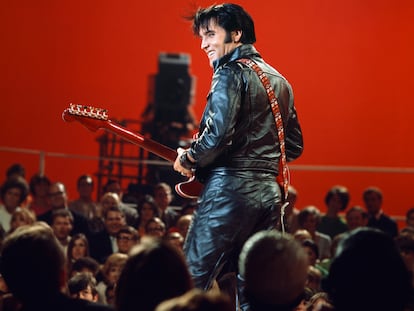Chevy Chase, the beloved comedian who was a monster off camera: ‘Not everyone hated him, just the people who’ve worked with him’
A film about ‘Saturday Night Live’ has revived interest in its first star’s controversial career as a beloved icon of humor who was a real nightmare for those with whom he shared a set
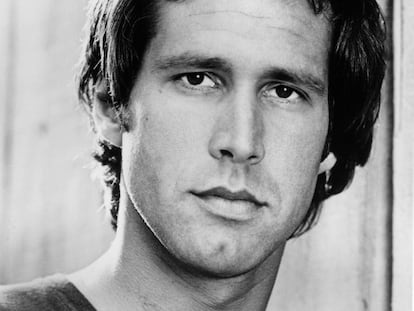
“Hi, I’m Chevy Chase and you’re not,” was a phrase popularized by the man himself in 1975. It may have aroused jealousy at the time, but by 2018, The Telegraph was publishing a profile about the performer with the cutting headline “Mean, arrogant, delusional: why did America fall in love with Chevy Chase?” The article claimed that if Bill Cosby (who was being hit by sexual abuse allegations from dozens of women) was the country’s most hated comic, Chase should be a good candidate for runner-up. His offense? A long list of racist insults and homophobic, misogynist, and violent incidents. They took place constantly throughout a career whose beginnings have recently been portrayed by Jason Reitman in Saturday Night, a Saturday Night Live biopic that captures the birth of one of the most iconic programs in U.S. television history. Chase, who was a member of SNL’s original cast, was one of the show’s most conflictive actors. He was also its first star, and its first alumnus to find success in Hollywood.
Saturday Night Live was a “disruptive” program, in the words of its creator Lorne Michaels, one that found itself in precisely the right place at the right time. NBC’s reigning star of the moment was Johnny Carson, who was considered to be a comic deity, an elegant performer who delivered a kind of comedy suitable for the whole family. The channel had an open slot on Saturday night, and was looking for a show that would appeal to a youthful audience who had begun to view television with suspicion. They bet on Michaels and his young posse, though they were under constant surveillance, and perhaps, with good reason. Thanks to Saturday Night Live, counterculture arrived direct to U.S. living rooms. Its first episode featured the irreverent George Carlin, his presence a mission statement if ever there was one, and its original cast included John Belushi, Dan Ackroyd, and Jane Curtain. Also on set that first night was the undefinable Andy Kauffman and Albert Brooks. But it was Chase who really kicked things off. It was from his mouth that the line that has now been on repeat for nearly 50 years first emanated: “Live, from New York, it’s Saturday night!”
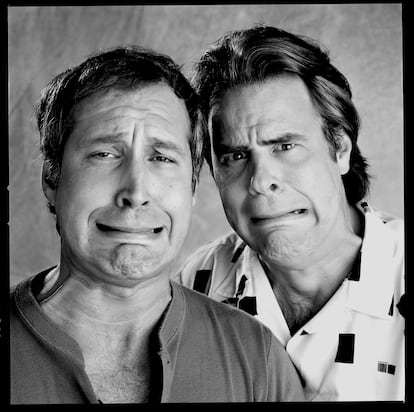
Chevy Chase, of course, is a stage name, hailing from the Medieval poem The Ballad of Chevy Chase. The actor’s real moniker is Cornelius Crane Chase, which perhaps gives away the moneyed background from which he hails. Chase is a descendent of the Puritans who arrived in the United States on the Mayflower, and he attended elite schools growing up, managing to be expelled from college after somehow getting a cow up to his fourth-floor dorm room. He was pre-med, but proved more passionate about comedy than becoming a doctor. After eventually graduating, he began to play the drums with Walter Becker and Donald Fagen, who wound up founding Steely Dan. Later, he swapped out the drumsticks for satire magazines like Mad and also for the airwaves, becoming part of The National Lampoon Radio Hour with some of his future SNL castmates.
On NBC, Chase rose to fame parodying Gerald Ford’s clumsy mannerisms, and holds the honor of having starred in one of the sketches that has long since ascended to the program’s immortal offerings. In it, he interviews Richard Pryor for a janitorial position, a scene that devolves into racial slurs that today could only be broadcast hidden under a flurry of bleeps. Pryor so terrified NBC that network executives demanded that his appearance be broadcast with a 10-second delay. Chase, who was a huge fan of the comic’s talents, begged to do a sketch with him, despite (absolutely correct) suspicions that Pryor hated him. After their incredibly successful first season, Chase announced he was leaving the show. His girlfriend, actress Jacqueline Carlin, was sick of New York and wanted to move to Los Angeles. Hollywood awaited them, eagerly.
Goodbye, don't come back
“Not everyone hates Chevy Chase. Just the people who have worked with him,” wrote Matt Solomon in Cracked. And perhaps that is why no one at SNL mourned his departure. He created a bad atmosphere on a show where everyone competed against everyone else and cocaine was rampant, a terrible combination. His disputes with Belushi were legendary. His co-host Jane Curtin was fed up with his antics. The atmosphere on the show was, in general, one of rampant misogyny. Belushi, for example, boycotted sketches written by women. “Chevy was handsome, but a little mean,” said his co-host Laraine Newman. “He was always trying to hurt your feelings.” That is what he did on one of his returns to the show as host.
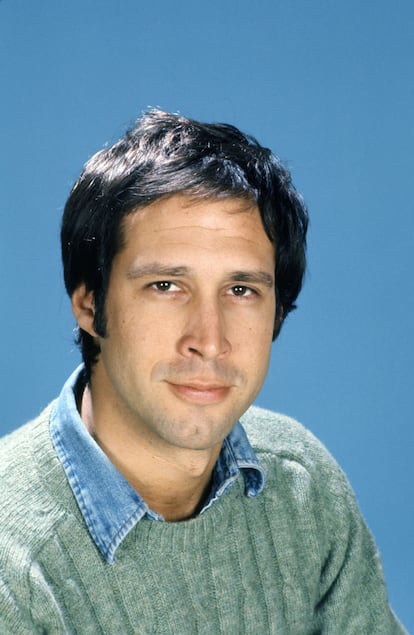
Bill Murray, who stepped in as a replacement when Chase left the show, was the latter’s primary target. Chase made fun of Murray’s facial scars, comparing them to lunar craters, and Murray shot back with disrespectful comments about Chase’s marriage to Carlin. Five minutes before they went on the air, the two launched into a fist fight. Later, Murray justified the scuffle, saying, “When you become famous, you’ve got like a year or two where you act like a real asshole. You can’t help yourself. It happens to everybody. You’ve got like two years to pull it together — or it’s permanent.”
On previous visits to the show, Chase insulted Robert Downey Jr., making fun of his father’s career. He went even further with Terry Sweeney, the first openly gay comedian on the show. Chase suggested that they include a weekly recurring gag around whether Sweeney had AIDS. “He was a monster,” said Will Ferrell in Live From New York: An Uncensored History of Saturday Night Live, referring to a night in 1997 when Chase suggested to a female writer, “Maybe you can give me a hand job later.”
Michaels threatened him with being banned from the show, and Chase told anyone who would listen how the program had gone downhill after his exit. He wasn’t just hated by current cast members, but also the other NBC hosts. When rumors circulated that the network was considering him as Carson’s replacement, the legendary Tonight Show host did not mince words. “Chase couldn’t ad-lib a fart after a baked-bean dinner,” were Carson’s precise thoughts. Even viewers could sense some of Chase’s contempt and arrogance, which he hardly deigned to mask on camera. For whatever reason, it didn’t diminish their love for the man at the time.
Not Chevy
The public’s fascination with the actor became clear after the release of Caddyshack (1980), a golf comedy in which he was reunited with Murray and that cleaned up at U.S. box office. He scored additional hits with National Lampoon’s Vacation (1983), Spies Like Us (1985), and Three Amigos (1986). Chase’s Fletch (1985) seemed to be the opening of a successful franchise, but when director Kevin Smith attempted to take on the third iteration, he ran up against its protagonist’s ego. “At the lunch, Chevy went on to claim he invented every funny thing that ever happened in the history of not just comedy, but also the known world,” Smith would later recall.
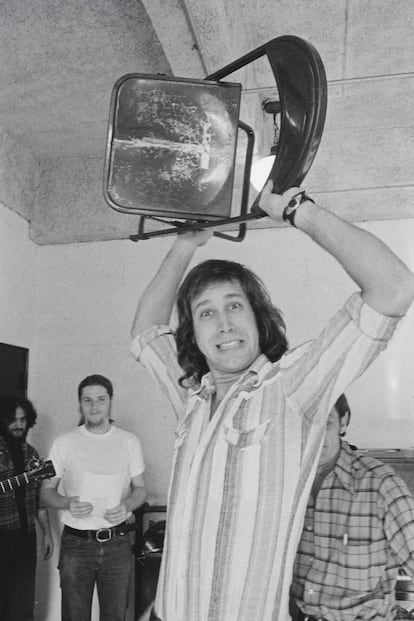
So began Chase’s gradual fall from grace, which no one else in the industry seemed too sad about. Smith was not the first director who declined to work with him. When Chris Columbus was still just a screenwriter, having penned both Gremlins and Young Sherlock Holmes, producer John Hughes offered to make his directing dreams come true with the Christmas follow-up to Vacation. But after meeting Chase, Columbus turned tail and ran. At the time, the would-be director was living at his parents’ house and was hoping to move out. He knew directing the sequel would be his ticket to doing just that, but he didn’t feel capable of sharing a set with the actor. “Chevy treated me like garbage,” he said. “I need to work, but I can’t do it with this guy,” he told Hughes (who offered him Home Alone as compensation, with the rest being, as they say, history).
At the end of the 1980s, Chase was at the peak of his career. His films were released to massive success, fans adored him and Hollywood humored him. He charged $7 million per film and hosted the Oscars on two occasions. It was the era in which deplorable off-camera behavior had no impact on a man’s career. But a couple of missteps would change everything.
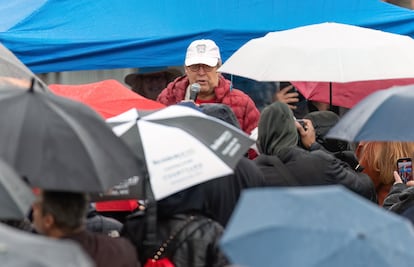
National Lampoon’s Christmas Vacation (1989) was a hit, but it would prove to be Chase’s last. His career began to crumble after a pair of clunkers, having taken a big bet on Memoirs of an Invisible Man (1992) and losing it all. The Washington Post wrote in a review that it was “not a movie. It’s an identity crisis.” The film’s director, the legendary John Carpenter, would say years later that shooting it had been a “horror story” that made him want to quit the project.
Now what?
After his fall from cinematic grace, Chase sought refuge once again on television. He starred in a talk show on FOX that only lasted a couple of months. His physical deterioration also became evident. He announced that he was starting treatment at the Betty Ford Clinic for an addiction to pain pills that had been originally prescribed for back pain, but it was an open secret that his actual problem was with cocaine. The “funniest man in America” had become a parody of himself. The final nail was hammered during his celebrity roast, which was strangely bereft of any actual celebrities, given that Chase had no friends. Instead, a parade of strangers tore into a man who had been famous 20 years ago. “What happened to Chevy’s career? I can answer that question in three… grams,” joked Paul Shaffer as Chase sank into silence behind a pair of sunglasses.
More recently, Chase had only appeared in small roles on Hot Tub Time Machine (2010) and its sequel. His big chance to redeem himself came when Dan Harmon added him to the cast of the extremely funny NBC sitcom Community. Chase’s Pierce Hawthorne, an intolerant, racist, misogynist magnate, seemed like a version of the actor himself. He accordingly showed everyone he was the same as ever — to no one’s delight. It didn’t take long for rumors of behind-the-scenes conflicts to circulate. Chase refused to film the scenes he didn’t find funny, and friction with his co-stars was a constant.
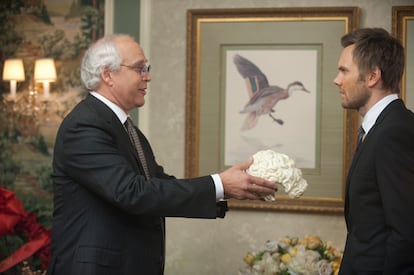
Joel McHale says that Chase constantly tried to physically fight him, but that the worst part was the envy-fueled, racist comments Chase let loose in the presence of Donald Glover. The young actor would later speak of the situation in The New Yorker: “I just saw Chevy as fighting time — a true artist has to be OK with his reign being over. I can’t help him if he’s thrashing in the water. But I know there’s a human in there somewhere — he’s almost too human.”
Chase’s battles with the series’ creator were also brutal. He was eventually fired for showing up drunk to set and for falling asleep at work, but things had reached their boiling point when Harmon and his crew started chanting “Fuck you, Chevy” in front of the actor’s wife and daughter. He responded to that humiliation with a furious voicemail. He hasn’t appeared in a major project since, and today, his primary occupation is supporting his classic films and selling merchandise through his Instagram account. The long-awaited Community movie seems to have been given the green light, but Pierce Hawthorne doesn’t seem to be returning to its cast. What a relief that he is Chevy Chase, and we are not.
Sign up for our weekly newsletter to get more English-language news coverage from EL PAÍS USA Edition
Tu suscripción se está usando en otro dispositivo
¿Quieres añadir otro usuario a tu suscripción?
Si continúas leyendo en este dispositivo, no se podrá leer en el otro.
FlechaTu suscripción se está usando en otro dispositivo y solo puedes acceder a EL PAÍS desde un dispositivo a la vez.
Si quieres compartir tu cuenta, cambia tu suscripción a la modalidad Premium, así podrás añadir otro usuario. Cada uno accederá con su propia cuenta de email, lo que os permitirá personalizar vuestra experiencia en EL PAÍS.
¿Tienes una suscripción de empresa? Accede aquí para contratar más cuentas.
En el caso de no saber quién está usando tu cuenta, te recomendamos cambiar tu contraseña aquí.
Si decides continuar compartiendo tu cuenta, este mensaje se mostrará en tu dispositivo y en el de la otra persona que está usando tu cuenta de forma indefinida, afectando a tu experiencia de lectura. Puedes consultar aquí los términos y condiciones de la suscripción digital.
More information
Archived In
Últimas noticias
Chris Martin, Taylor Swift, Elijah Wood and other famous wedding ‘crashers’
‘How does it feel to be a failure?’: Elizabeth Berkley’s journey from ‘Showgirls’ ridicule to vindication
The story of the Málaga virus: The code that haunted Google’s cybersecurity center director for 30 years
The impact of Ecuador’s mega-prison: A polluted river, cleared forests and military checkpoints
Most viewed
- Christian Louboutin: ‘Young people don’t want to be like their parents. And if their parents wear sneakers, they’re going to look for something else’
- The low-cost creative revolution: How technology is making art accessible to everyone
- Liset Menéndez de la Prida, neuroscientist: ‘It’s not normal to constantly seek pleasure; it’s important to be bored, to be calm’
- All the effects of gentrification in one corner of Mexico’s Colonia Roma
- December Social Security and SSI payments: Dates, double checks and the 2026 COLA increase


